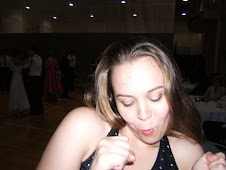In these videos, Michael Mitchell and Amanda Melton demonstrate the basic for waltz. The basic consists of a basic box step and the rotating box step. The rotating box step, allows dancers to move counter clockwise across the floor. This rotating is what gives waltz its characteristic spinning effect and gives the dance movement across the floor.
The Basic Box Step
\
The Rotating Box Step
Wednesday, October 17, 2007
Waltz - 1, 2, 3
Posted by
UGA Ballroom Dance Club
at
7:05 PM
0
comments
![]()
Tuesday, October 16, 2007
Back to the Basics
In ballroom dance ‘The Basic’ refers to the most simple and fundamental steps of any dance. A dancer could easily go through any entire song with only the basic steps, it would however become dull very quickly. More often the basic is used as ‘home’, a place to come back to after doing special moves to regain the feel of the dance. As dancers become more advanced they return the basic less and less, filling the dance with strings of combination of moves that flow into each other.
Posted by
UGA Ballroom Dance Club
at
6:15 PM
0
comments
![]()
Labels: Basic, General Info
Sunday, October 14, 2007
Waltz- Its not just for Princesses



The waltz is probably the most recognizable of all the ballroom dances. Immortalized by Disney and other movie corporations, it is burned in our mind as the dance of prince and princesses. It is romantic yet distanced, unlike its Latin counter-part the Rumba which displays more of the physical understanding of love.
Waltz is considered a Standard or Smooth dance, as opposed to a Rhythm or Latin dance.
Its danced primarily in Closed position. The movement is conducted in ¾ time in which the down beat or beat #1 is emphasized. The movement of the dance has long smooth steps and follows a gentle rise and fall pattern. The most characteristic movements are pivots, hesitation and dips.
Posted by
UGA Ballroom Dance Club
at
9:15 AM
0
comments
![]()
Labels: Waltz
Saturday, October 13, 2007
Closed Frame- Getting close with your partner
Frame is the relationship of positions that you dance in with your partner. There are many stylistic variations on frame, but generally there are two frames: open and closed. In closed frame dancers hold each other closely while dancing, whereas in open frame dancers merely hold each others hands allow for an open space to form between them.
This video demonstrates how to dance in closed frame. This frame is used in all ballroom dances but is most recognized in dances such as waltz, foxtrot, rumba and tango where many of the moves originate from closed frame.
Wednesday, October 10, 2007
West Coast Example
In this clip Canadian champions Ben Morris and Tessa Cunninghamin dance a super smooth West Coast Swing.
Posted by
UGA Ballroom Dance Club
at
12:07 PM
1 comments
![]()
Labels: Demo, West Coast
Sunday, September 30, 2007
Dressing Your Feet
Watching dancers, as in the west coast video in the post below, it is amazing to see dancers slide across the floor as they were dancing on ice. While 95% of this ability is skill, ballroom dancers do get a help from their shoes.
 Unlike ordinary heels and dress shoes, ballroom shoes have a suede soles that allow for gliding. Suede is ideal because it slick but not, lose control of your limbs, fall over on your bum slick.
Unlike ordinary heels and dress shoes, ballroom shoes have a suede soles that allow for gliding. Suede is ideal because it slick but not, lose control of your limbs, fall over on your bum slick.
 Dancers keep control of the smoothness of the shoes by brushing the suede after dancing. By brushing the the soles of their shoes dancers pull up the suede making it rougher and increasing the friction the suede has with the floor.
Dancers keep control of the smoothness of the shoes by brushing the suede after dancing. By brushing the the soles of their shoes dancers pull up the suede making it rougher and increasing the friction the suede has with the floor. 
Although dance shoes have many benefits, they can be expensive. Most shoes run around from $80 to $130. Many beginners choose to dance in socks, ballet shoes, and bowling shoes. While others simply find dress shoes that have fairly slick soles.
Posted by
UGA Ballroom Dance Club
at
11:55 AM
0
comments
![]()
Labels: General Info
Wednesday, September 19, 2007
Two Left Feet
I mean technically, I have both a right and a left foot; they just aren't always that coordinated. I love ballroom dance and quite haphazardly I became the president of the University of Georgia's Ballroom Dance Club. They didn't make the decision based on my dancing ability. In fact I would have failed the Cha-Cha part.
So maybe your wondering why are you reading a dance blog from a girl who can't even successfully Cha-Cha?
The answer is that while I can't Cha-Cha, I know a few people who can and since I'm already bumming lesson off them, Why not share those lessons with everyone?
So began " Two Left Feet" a blog about learning the steps of some our favorite ballroom moves and all the basics. We will walk you through the steps and you can let your mirror be your judge. When you got everything mastered in your living room or your just ready to get moving I hope that you'll go out and dance in your community and let us know how it went.
Also:
For all those dancers out there who are already fabulous, post some your favorite moves. We'd love to see them and bask in your glory.
Happy Dancing
Posted by
UGA Ballroom Dance Club
at
9:26 PM
0
comments
![]()


